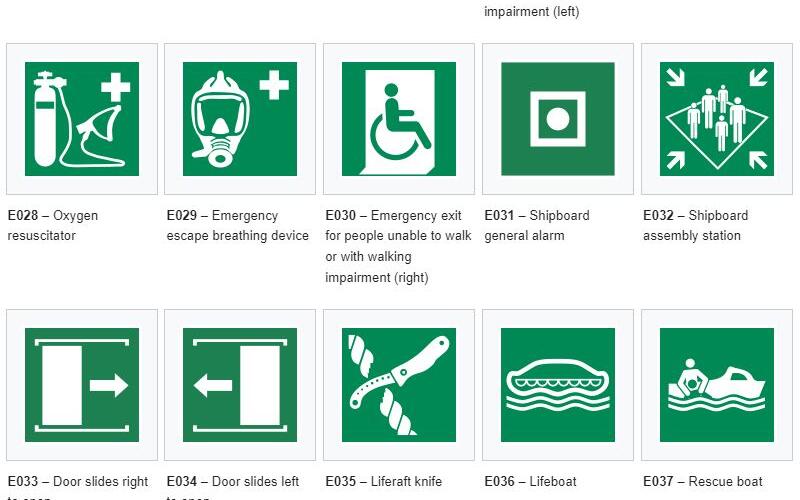Introduction: Understanding the Vital Role of Safety Signs
Welcome to our exploration of the world of safety signs, an often overlooked but crucial aspect of maintaining safety in our daily environments. From bustling workplaces to public spaces, safety signs serve as silent guardians, guiding us through potential hazards and ensuring we navigate our surroundings safely.
Imagine walking into a construction site without any warning signs. The risks would be immediately apparent – from falling debris to electrical hazards. This is where safety signs come into play, acting as essential tools for risk communication. They are not just mere symbols; they are a language in themselves, speaking to us through colours, shapes, and symbols, universally understood across cultures and languages.
In this article, we delve into the different types of safety signs - warning signs, mandatory signs, prohibition signs, and more. Each type serves a unique purpose, from alerting us to potential dangers to informing us of necessary actions for safety. For instance, a warning sign might caution us about a wet floor, while a mandatory sign could indicate the need to wear protective equipment.
But why are these signs so important? They are integral to not just personal safety, but also legal compliance in many scenarios. Workplaces, in particular, are bound by stringent health and safety regulations that mandate the use of specific signs. Failing to adhere to these can lead to not just accidents but also legal repercussions.
Thus, understanding the various types of safety signs is not just about compliance; it's about fostering a culture of safety and awareness. Whether you're an employer, an employee, or just a member of the public, a good grasp of safety signage is a skill that benefits everyone. So, let's embark on this informative journey and unravel the meanings and significance of these pivotal symbols that dot our daily landscapes.
The Importance of Safety Signs: A Crucial Element in Risk Management
Safety signs are far more than mere functional elements; they are a vital component in the tapestry of risk management and safety protocols. Their role extends beyond the simple act of conveying information – they are integral in shaping a safe and aware culture in various environments, from industrial workplaces to public spaces.
Averting Potential Hazards
The primary role of safety signs is to alert individuals to potential hazards. By providing clear and concise information, these signs can significantly reduce the risk of accidents and injuries. For instance, a warning sign indicating a high voltage area can prevent a potentially fatal accident. Similarly, a sign pointing out a slippery surface can prevent slips and falls, one of the most common workplace injuries.
Legal Compliance and Responsibilities in Ireland
In Ireland, the importance of safety signs is underscored by strict legal requirements. The Safety, Health and Welfare at Work (General Application) Regulations 2007, especially Part 7: Chapter 1 of the regulations, outlines the requirements for safety signage in workplaces. These regulations are part of Ireland's commitment to ensuring a safe working environment for all employees.
Under these regulations, employers are obliged to provide specific signs whenever there is a risk that cannot be avoided or adequately reduced. This legal mandate ensures that both employers and employees are constantly reminded of potential hazards and the necessary precautions to take. The use of safety signs is not just a legal obligation but also a moral one, as it directly impacts the wellbeing of individuals.
Educating and Informing
Another critical aspect of safety signs is their role in education. For new employees or visitors to a site, these signs provide crucial information about the environment and the behaviour expected of them. This aspect is particularly important in high-risk areas, where unfamiliarity with the environment can lead to serious accidents.
Consistency and Universal Understanding
The design of safety signs in Ireland, as in many parts of the world, follows specific international standards, such as those laid out in the ISO 7010. This standard ensures that safety signs are consistent and universally understandable, regardless of language or cultural background. This consistency is crucial in our globalised world, where workers from diverse backgrounds may find themselves in various work environments.
Safety signs play a multifaceted role in ensuring safety and compliance. They are preventative tools, legal necessities, educational resources, and universal communicators all rolled into one. In Ireland, adherence to the legal requirements not only ensures compliance but also demonstrates a commitment to creating a secure and informed workplace. As we continue to navigate through different spaces, it's essential to recognise and appreciate the silent yet significant role these signs play in keeping us safe.
Types of Safety Signs: Deciphering the Language of Safety
In the realm of safety signage, understanding the various types is key to interpreting the messages they convey. In Ireland, as in many parts of the world, safety signs are categorised to address different safety needs and scenarios. This section focuses on one of the most critical types: Warning Signs.
Warning Signs: The Herald of Hazards
Warning signs are perhaps the most instantly recognisable due to their distinct yellow background and black pictogram. These signs are designed to alert individuals to potential hazards or dangers that, if not heeded, could result in injury or even death.
-
Design and Symbolism:
- The design of warning signs is governed by the ISO 7010 standard, ensuring uniformity and recognisable symbolism.
- The yellow background symbolises caution, with a black border for added visibility. The pictograms are simple yet descriptive, depicting the nature of the hazard.
-
Examples of Warning Signs in Ireland:
- Electrical Hazard Signs: Indicate the presence of high voltage or electrical risks.
- Chemical Hazard Signs: Used in areas where hazardous chemicals are stored or used.
- Flammable Material Signs: Warn about materials that can easily ignite or explode.
- Slippery Surface Signs: Common in both public and private sectors, indicating areas where slips could occur.
- Falling Hazard Signs: Found in areas like construction sites, warning of potential falling objects.
-
Locations and Contexts:
- Warning signs are ubiquitous across various settings in Ireland, from construction sites and manufacturing plants to public areas like shopping centres and parks.
- The context of use is crucial; for example, a chemical hazard sign in a laboratory conveys a different level of risk than one in a cleaning closet.
-
Legal Requirements in Ireland:
- Under the Safety, Health and Welfare at Work (General Application) Regulations 2007, employers are required to assess risks and, where necessary, put up appropriate warning signs.
- The choice of sign must be appropriate to the level of risk and easily understandable to those who are exposed to the risk.
-
Impact on Safety Culture:
- The presence of warning signs is not just a legal compliance issue but also a reflection of an organisation's commitment to safety.
- These signs play a vital role in fostering a culture of safety awareness, reminding individuals to be vigilant and take necessary precautions.
Warning signs are a fundamental aspect of safety signage, serving as crucial indicators of potential hazards in various environments. In Ireland, their use is not only a legal requirement but also a key element in promoting a safe and aware workplace and public spaces. Understanding these signs and their implications is essential for everyone, contributing to a safer and more informed society.
Mandatory Signs: Enforcing Essential Safety Actions
Mandatory signs are a vital component in the constellation of safety signage, particularly in environments where specific actions or behaviours are required to ensure safety. These signs play an instrumental role in communicating what must be done to mitigate risks and maintain a safe environment. Unlike warning signs that alert about potential hazards, mandatory signs instruct on essential actions.
Characteristics and Design
-
Visual Design:
- Mandatory signs are easily identifiable by their distinctive blue background with a white pictogram or text.
- This colour scheme is chosen for its universal association with mandatory actions and instructions.
-
Symbolism:
- The pictograms used are simple, clear, and direct, designed to convey the required action without ambiguity.
- Common symbols include representations of safety equipment like hard hats, safety glasses, or ear protection.
Examples of Mandatory Signs
-
Personal Protective Equipment (PPE) Signs:
- Indicate the need for specific safety gear, such as helmets, gloves, or safety shoes.
- These are especially prevalent in construction sites, manufacturing plants, and laboratories.
-
Hygiene and Health Signs:
- Signs mandating hand washing or the use of sanitizers, particularly relevant in healthcare facilities, food processing plants, and during health crises.
-
Access and Movement Regulation Signs:
- Direct traffic flow, indicate fire doors, or specify areas where access is restricted to authorised personnel only.
Legal Requirements and Compliance in Ireland
-
Regulatory Framework:
- In Ireland, the use of mandatory signs is often stipulated under various health and safety regulations.
- The Safety, Health and Welfare at Work (General Application) Regulations 2007 play a significant role in defining these requirements.
-
Employer Responsibilities:
- Employers are required to identify situations where specific actions are necessary for safety and to display appropriate mandatory signs.
- This includes ensuring that employees are aware of and understand the meaning of these signs.
The Role of Mandatory Signs in Safety Culture
-
Promoting Compliance:
- Mandatory signs serve as constant reminders of the safety practices that need to be adhered to in a particular area.
- They help in building a culture where safety protocols are respected and followed.
-
Educational Aspect:
- These signs also have an educational role, especially for new employees or visitors who might be unfamiliar with specific site requirements.
- Through clear pictorial messages, they instruct and inform, ensuring that safety procedures are universally understood.
In essence, mandatory signs are a critical element in ensuring a safe and compliant working environment. They communicate essential safety-related instructions that, when followed, significantly reduce the risk of accidents and injuries. In Ireland, adherence to the legal guidelines regarding these signs is not only a matter of regulatory compliance but also a testament to an organization's commitment to maintaining a robust safety culture.
Prohibition Signs: Enforcing Safety Through Restrictions
Prohibition signs are an essential aspect of safety signage, playing a pivotal role in ensuring safety by clearly outlining actions or behaviors that are strictly forbidden. These signs are integral in various settings, from workplaces to public areas, where certain actions could pose a risk to safety or health.
Characteristics and Design
-
Visual Design:
- Prohibition signs are characterized by their distinct red circle with a diagonal line through it, encompassing a black pictogram on a white background.
- This design is universally recognized and is effective in immediately drawing attention and conveying a clear message of prohibition.
-
Symbolism:
- The symbols used on these signs are straightforward, depicting the action or item that is not allowed.
- The red circle and diagonal line are powerful visual cues for 'stop' or 'not allowed', making these signs instantly understandable.
Common Types of Prohibition Signs
-
No Smoking Signs:
- These are among the most recognized prohibition signs, indicating areas where smoking is strictly prohibited due to health risks or potential hazards like fire.
-
No Entry Signs:
- Used to restrict access to certain areas for safety or security reasons, these signs are critical in controlling movement in various environments.
-
No Eating or Drinking Signs:
- Common in environments where hygiene and cleanliness are paramount, such as laboratories or food processing areas.
-
No Photography Signs:
- Often found in sensitive areas where privacy and confidentiality are crucial, such as in certain corporate or government buildings.
Legal Requirements and Compliance in Ireland
-
Regulatory Framework:
- In Ireland, the use of prohibition signs is often governed by specific health and safety legislation, including the Safety, Health and Welfare at Work (General Application) Regulations 2007.
- These regulations stipulate when and where prohibition signs should be used to prevent accidents and maintain safety standards.
-
Employer Responsibilities:
- Employers are responsible for identifying potential risks in their premises and ensuring the appropriate prohibition signs are displayed to mitigate these risks.
- It is also important for employers to ensure that all personnel are aware of and understand the meaning of these signs.
Impact on Safety Culture
-
Reinforcing Safe Practices:
- Prohibition signs play a crucial role in reinforcing safe practices by clearly stating what is not permissible, thereby preventing potentially hazardous actions.
- They help in cultivating a safety-first mindset among employees and visitors.
-
Universal Communication:
- Given their straightforward design and universal symbols, these signs are effective in communicating important restrictions across language and cultural barriers.
In summary, prohibition signs are a fundamental component of safety signage, providing clear and unambiguous communication about actions that are not allowed. Their role in maintaining safety and compliance in various settings is invaluable. In Ireland, adhering to the legal requirements for these signs not only ensures a safer environment but also demonstrates an organisation’s commitment to upholding high safety standards.
Design and Visibility of Safety Signs: Ensuring Effective Communication
The design and visibility of safety signs are critical factors in their effectiveness. These signs must be designed to convey vital safety information clearly and be visible enough to ensure that this information is communicated effectively. In this section, we delve into the key aspects of design and visibility that make safety signs in Ireland functional and reliable.
Adherence to Design Standards
-
Standardisation:
- Safety signs in Ireland adhere to international standards, such as ISO 7010, which provides guidelines on the design of safety signs for consistency and universal understanding.
- This standardisation ensures that the signs are recognisable and their messages are clear, regardless of the viewer's background.
-
Colour Coding:
- Specific colours are used to convey different types of messages: red for prohibition, green for emergency or safe conditions, yellow for caution, and blue for mandatory actions.
- The consistent use of these colours aids in quick recognition and understanding.
Pictograms and Text
-
Pictograms:
- Pictograms are simple, graphic symbols that depict the nature of the warning, prohibition, or instruction.
- They are designed to be easily understood at a glance, which is crucial in situations where quick comprehension is necessary.
-
Textual Information:
- While pictograms convey the primary message, additional textual information may be included for clarification.
- The text should be concise, clear, and in a legible font to ensure that it can be easily read from an appropriate distance.
Visibility and Placement
-
Sizing and Location:
- The size of the signs and their placement are determined based on where they can be most effectively seen and understood.
- Signs must be large enough to be legible from a distance relevant to the hazard or instruction they are associated with.
-
Lighting and Environmental Considerations:
- Signs should be positioned in well-lit areas or made of reflective materials to ensure visibility under all lighting conditions.
- Environmental factors, such as exposure to sunlight, rain, or chemicals, should be considered in the material choice to ensure durability and continued visibility.
Legal Compliance in Ireland
-
Regulations:
- In Ireland, compliance with health and safety regulations includes ensuring that safety signs meet the required design and visibility standards.
- The Safety, Health and Welfare at Work (General Application) Regulations 2007 includes specific provisions regarding the design, placement, and maintenance of safety signs.
-
Employer Responsibility:
- Employers must ensure that safety signs are appropriately designed, placed, and maintained. This includes regular checks to ensure that signs remain visible and legible over time.
Impact on Safety Awareness
The design and visibility of safety signs are not merely about compliance; they are about ensuring that crucial safety information is effectively communicated. Well-designed and visible signs are integral to maintaining a safe environment, helping prevent accidents and injuries. In Ireland, where adherence to safety standards is a legal requirement, the proper design and placement of these signs are vital in creating and sustaining a culture of safety and awareness.
Safety Sign Maintenance and Compliance: Upholding Standards for Continued Safety
Maintaining safety signs and ensuring compliance with relevant regulations are critical components of effective safety management. In Ireland, as in many other countries, this involves a combination of regular maintenance, adherence to legal standards, and continuous evaluation of safety signage needs. This section outlines the key aspects of safety sign maintenance and compliance, focusing on the steps organisations should take to uphold the highest safety standards.
Regular Maintenance of Safety Signs
-
Inspection and Cleaning:
- Regular inspections should be conducted to ensure that safety signs are in good condition, clearly visible, and legible.
- Signs should be cleaned periodically to remove dirt, dust, or any substances that could impair visibility or readability.
-
Damage and Wear Assessment:
- Safety signs exposed to harsh environmental conditions, like extreme weather or chemical exposure, can deteriorate or fade over time.
- Any signs showing signs of wear, fading, or damage should be replaced promptly to ensure that they continue to convey the necessary safety message effectively.
-
Updating Signage:
- As workplaces evolve and new hazards emerge, it may be necessary to update or add new signs.
- Regular reviews of the workplace environment will help identify any changes in safety requirements, ensuring that signage remains relevant and up-to-date.
Compliance with Safety Regulations in Ireland
-
Adhering to Legal Standards:
- In Ireland, the compliance of safety signs with legal standards is governed by the Safety, Health and Welfare at Work (General Application) Regulations 2007.
- These regulations specify the requirements for the design, placement, and maintenance of safety signs in the workplace.
-
Employer Responsibilities:
- Employers are responsible for ensuring that safety signs meet the necessary standards and are maintained correctly.
- This includes conducting risk assessments to determine the need for safety signage and ensuring that all signs comply with the relevant regulations.
Continuous Evaluation and Improvement
-
Regular Risk Assessments:
- Conducting regular risk assessments helps in identifying new hazards that may require the installation of additional safety signs.
- These assessments should be part of an ongoing process to continuously improve workplace safety.
-
Training and Awareness:
- Employees should be trained to understand the meanings of safety signs and the importance of adhering to the warnings or instructions they provide.
- Regular training sessions can help reinforce the significance of safety signage and encourage a culture of safety in the workplace.
-
Feedback and Reporting Mechanisms:
- Establishing a system for employees to report damaged, obscured, or missing signs can be beneficial in maintaining signage effectiveness.
- Employee feedback can also provide insights into potential areas for improvement in safety communication.
The maintenance and compliance of safety signs are not static tasks but dynamic processes that require ongoing attention and adaptation. In Ireland, ensuring that safety signs meet legal requirements and are well-maintained is essential for creating a safe working environment. Regular inspections, adherence to regulations, and continuous evaluation play a key role in this process, contributing to the overall safety and well-being of everyone in the workplace.
Case Studies or Real-Life Examples: Learning from Practical Scenarios
Incorporating real-life examples or case studies in the discussion about safety signs offers valuable insights into their practical applications and effectiveness. These stories not only illustrate the importance of safety signage but also highlight the consequences of non-compliance or negligence. Here are two case studies from Ireland that demonstrate the impact of safety signs in real-world scenarios.
Case Study 1: Construction Site Accident Averted
Background: In a busy construction site in Dublin, a large area was designated for heavy machinery operation. Despite the inherent risks, the site initially lacked adequate warning signs.
Intervention: After a near-miss incident involving a pedestrian walking into the machinery operation zone, the site management conducted a thorough risk assessment. They subsequently installed prominent warning signs around the perimeter of the zone, clearly indicating the danger and prohibiting unauthorised access.
Outcome: The introduction of these warning signs led to a significant decrease in unauthorised entries into the hazardous area. Workers and visitors became more aware of the risks, and no further near-miss incidents were reported. This case highlights the crucial role of warning signs in accident prevention.
Case Study 2: Improved Safety in a Pharmaceutical Plant
Background: A pharmaceutical manufacturing plant in Cork was handling various chemicals, some of which were hazardous. The plant had basic safety signs in place, but they were not fully compliant with the latest standards.
Intervention: Following an external safety audit, the plant updated its safety signs to comply with ISO 7010 standards. This included the installation of new chemical hazard signs, mandatory PPE signs, and emergency information signs.
Outcome: The updated signage resulted in improved safety awareness among employees. There was a noticeable increase in the correct usage of personal protective equipment, and emergency response times improved due to clearer emergency information signage. This case demonstrates the importance of compliance with safety sign standards and continuous improvement.
Reflections
These case studies from Ireland underscore the real-world importance of safety signs. They show that effective safety signage is not just about legal compliance; it’s about actively protecting people from harm. Whether it’s preventing accidents in high-risk areas like construction sites or ensuring safe practices in specialised environments like pharmaceutical plants, safety signs play a vital role.
Furthermore, these examples highlight the need for ongoing risk assessments and readiness to update safety measures as necessary. Safety signs are an integral part of a dynamic safety culture, evolving as the workplace and its hazards evolve. By learning from these real-life scenarios, organisations can better understand the value of safety signs and the importance of their correct implementation and maintenance.
Conclusion: Emphasising the Imperative Role of Safety Signs
As we conclude our exploration into the world of safety signs, it's clear that these symbols are much more than mere regulatory requirements. They are, in essence, the silent guardians of our daily safety, speaking a universal language that transcends cultural and linguistic barriers. In Ireland, as in many parts of the world, safety signs play a critical role in mitigating risks, preventing accidents, and promoting a culture of safety awareness in various environments.
Key Takeaways
-
Vital Role of Different Types of Signs:
- We've seen how warning, mandatory, and prohibition signs each serve a unique and crucial function. Warning signs alert us to potential hazards, mandatory signs instruct us on necessary actions for safety, and prohibition signs clearly delineate what is not permitted.
-
Design and Visibility are Paramount:
- The effectiveness of safety signs hinges on their design and visibility. Adhering to international standards like ISO 7010 ensures that these signs are universally understandable, while their strategic placement and maintenance guarantee that they remain visible and effective.
-
Legal Compliance and Beyond:
- In Ireland, complying with the Safety, Health and Welfare at Work (General Application) Regulations 2007 is not just a legal obligation but a moral one. It reflects an organisation's commitment to the safety and well-being of its people.
-
A Dynamic, Ongoing Process:
- Maintaining safety signage is not a one-time task but an ongoing process. Regular inspections, updates, and employee training are essential to ensure that these signs continue to serve their purpose effectively.
-
Learning from Real-Life Applications:
- The case studies from Ireland illustrate the tangible impact of safety signs. They highlight how the right signage can avert potential disasters and foster a safer work environment.
Final Thoughts
Safety signs are an indispensable part of our daily lives, guiding us through potential dangers and ensuring our wellbeing. In Ireland, the careful implementation and maintenance of these signs are not just a legal requirement but a testament to an organisation's dedication to safety. As we navigate our world, let's remember the importance of these signs and the role they play in keeping us safe. Whether in a bustling workplace or a public space, safety signs are a crucial element in our collective effort to create a safer, more aware society.
Call to Action: Partner with Time for Designs for Your Safety Sign Solutions
As we wrap up our comprehensive guide on the importance of safety signs, it's time to turn our attention to practical solutions. Whether you're a business owner, a health and safety officer, or someone in charge of ensuring a safe environment, the significance of high-quality, compliant safety signage cannot be overstated. This is where Time for Designs steps in – your expert partner in creating safety signs that not only meet legal requirements but also enhance the safety culture of your space.
Why Choose Time for Designs?
-
Expertise in Design and Compliance:
- Our foundation in web design, combined with extensive experience in print, positions us uniquely to craft safety signs that are not just visually striking but also fully compliant with Irish regulations.
-
Custom Solutions for Your Unique Needs:
- We understand that every space is different. That's why we offer bespoke safety signage solutions tailored to the specific requirements of your workplace or public area.
-
Quality First Approach:
- At Time for Designs, we are committed to quality. From the choice of materials to the precision of the print, we ensure every sign meets our stringent standards.
-
End-to-End Service:
- Our team will guide you through the entire process – from the initial design consultation to the final installation of the signs, ensuring a hassle-free experience.
-
Enhancing Your Safety Culture:
- Beyond compliance, our signs are designed to be educational and to reinforce a culture of safety awareness among your employees and visitors.
Take the Next Step
Are you ready to elevate the safety and compliance of your space with expertly designed safety signs? Here’s how you can get started with Time for Designs:
-
Contact Us:
- Reach out to us through our website, email, or phone. We’re here to listen to your needs and provide a tailored solution.
-
Consultation:
- Schedule a consultation with our design experts. We’ll discuss your requirements, assess your space, and propose a signage plan that best suits your needs.
-
Design and Approval:
- Once you’re happy with the proposed designs, we’ll move forward with creating your custom safety signs.
-
Installation and Follow-Up:
- Our team will ensure a professional installation of your new safety signs. We also provide follow-up services to ensure your continued satisfaction.
Your Safety, Our Commitment
At Time for Designs, we’re not just a service provider; we’re your partner in safety. Every sign we create is a step towards a safer, more informed environment. Don't just comply with safety regulations; exceed them with Time for Designs. Contact us today and be part of our story of creativity, safety, and innovation. Let's make safety a visible priority together.








Comments (0)
Add a Comment